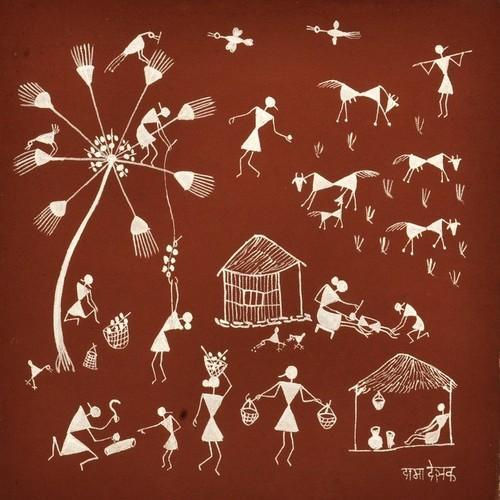Kalamkari Art
- CAMI Info
- Dec 3, 2021
- 4 min read
Updated: Jul 6, 2022
In ancient times, Kalamkari art was a domestic occupation for several rural women and craftsmen, and it is now passed down from generation to generation. Andhra Pradesh is still the country's principal kalamkari printing center. If you want to learn more about such art or how you can create such ancient paintings you can always visit the Children’s art museum of India to share and understand more about it. You can submit your art online here in the art children art museum as well.

Kalamkari literally means "pen craft," with "kalam" referring to the pen and "kari" to the art. It is one of the most elegant traditional Indian art forms, and it entails block printing or hand printing on cotton fabrics. The use of exclusively natural colors or vegetable dyes is a defining aspect of Kalamkari art.
How does it start?
Kalamkari art and printing are mostly found in Andhra Pradesh - Kalahasti and Machilipatnam, as well as a few other smaller towns. For a very crucial reason, Srikalahasti was the main hub of kalamkari art: it had a continuous supply of clean river water.
Because there was a growing demand for these prints on the worldwide market, kalamkari artists had to modernize some of the ancient, Hindu-mythology-inspired kalamkari subjects. As a result, Persian art began to have a significant influence on the original kalamkari designs.
Types of Kalamkari
Srikalahasti and Machilipatnam are the two distinct forms of Kalamkari. Kalamkari designs are often printed by hand in the Machilipatnam manner, using hand-carved blocks with elaborate detailing. Srikalahasti style, on the other hand, comprises Kalamkari designs based on Hindu mythology that depict scenes from the epics.
Based on the states where it is made, kalamkari designs have also emerged. Gujarat and Andhra Pradesh are two prominent states. These two states practice two different styles of Kalamkari designs. Andhra Pradesh's Kalamkari designs are inspired by forts, palaces, and temples, as well as animal and bird motifs, whereas Gujarat's Kalamkari designs are inspired by legendary characters.
Process of making Kalamkari Art
Indian art exhibition online gives you a chance to learn about the technique and process of Kalamkari art making. Dyeing, bleaching, hand painting, outline drawing, washing, and ironing are all part of the Kalamkari painting process. In a nutshell,chanderi or cotton cloth is purchased from the market and washed in plain water to remove starch and dried, then washed and soaked in a solution of cow dung, milk, and Chebulic myrobalan locally known as karakha pindhi for approximately 1 to 2 hours and dried, which is ready for the basic outline drawing with a burnt tamarind stick that acts as charcoal/ chalk piece, once the basic outline is completed, outlines The cloth is immersed in boiling water for the maroon/red color to adhere to the fabric.
Repeat the washing process until all of the colors have been applied. The cloth is then washed, ironed, and packaged to be shipped to the consumer at the end of the process.
Colors and Tools used in Kalamkari Art
Today in an art museums-like, Children’s art museum of India helps online art submission and there you can learn more about the various form of art.
The earthy tones of reds, blues, greens, yellows, and browns employed in Kalamkari are stunning. Women are shown in yellow, gods are depicted in blue, while demons are depicted in red and green. Synthetic dyes are absolutely prohibited, thus all colors are obtained through natural means. Madder roots provide red dye, pomegranate seeds or mango bark provide yellow dye, and myrobalam roots provide black dye.
A short bamboo stick is used to make a kalam or kalamkari pen. One end of the stick is sharpened till needed. And then the other one, pure cotton cloth is rolled on near the sharpened edge of the stick and tightly tied in a crisscross pattern with a cotton thread, ensuring that the cotton cloth stays in place. Cotton is employed because it works like an ink pillar, absorbs color, and allows the craftsman to draw on the fabric more easily. Many times, instead of cotton cloth, a lump of cotton is connected to the bamboo stick, allowing for greater color absorption. This is usually done on the interior of the fabric that needs to be painted.
The flow of ink is determined by the material used in kalam; for outlines, a cotton cloth (ex: bandage cloth) is utilized. The fineness of the line drawn is determined by the tip thickness.
Kalamkari Art in modern days
Today, however, most Kalamkari artists' children choose jobs in engineering, business, or other fields, given the number of professional possibilities available to create a regular and more lucrative income. Only roughly 16 talented Kalamkari artists are still alive and active today, with ten of them having won National Awards.
Final Thoughts
Today, it's difficult to think about Kalamkari's rich history without thinking about its future. Kalamkari, like many other forms of traditional Indian art, is a generational art, which means that a father or grandfather would normally instruct his offspring in the family trade. This is how it has been preserved and passed down for many years. Keeping art alive through generations is difficult if one wants to preserve it. Children’s art museum of India makes sure you can learn the art of expression through the Kalamkari art. If you are a parent or a child who wants to learn about this, Online art exhibits give you a chance to learn and showcase your talent with Children’s art museum of India you can always learn the new art technique and fell in love with our culture all over again with art.




Comments